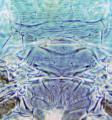Leucothrips nigripennis
Recognition data
Distinguishing features
Both sexes fully winged. Body and legs white, fore wings uniformly dark or black, antennal segment II dark, III–VII brown. Antennae 7-segmented, VII slender and longer than VI; sensoria forked on III–IV, segment VI with long simple sensorium arising close to base on inner margin. Head lacking sculpture. Pronotum transversely striate, with 2 pairs of prominent postero-angular setae. Metanotum with linear sculpture lines converging medially, median pair of setae small and arising medially. Tarsi all 1-segmented. Fore wing slender, pointed; first vein with 2 widely spaced setae on distal half, second vein without setae, postero-marginal cilia straight. Abdominal tergites II–VIII median setae long and close together; lateral thirds of tergites with transverse lines of sculpture bearing widely spaced, small microtrichia; VIII with postero-marginal comb of microtrichia. Sternites III–VII with 3 pairs of long postero-marginal setae.
Male with sensoria simple on antennal segments III–IV.
Related and similar species
Five species are recognized in the genus Leucothrips, three of which are known only from the Neotropics (Mound, 1999). As with other species of the Dendrothripinae, the metathoracic furca is enlarged and lyre-shaped, extending to the mesothorax.
Taxonomic data
Current valid name
Leucothrips nigripennis Reuter
Original name and synonyms
- Leucothrips nigripennis Reuter, 1904: 108
- Microthrips leucus Herrick, 1927: 278
- Sporangiothrips acuminatus Daniel, 1985: 528
Family placement
Thripidae, Dendrothripinae
Common names
Fern thrips
Biological data
Life history
Larvae feed on the fronds of various ferns.
Host plants
Various cultivated ferns (Adiantum sp., Davallia sp., Pteris cretica, P. alexandrae, P. wilsoni).
Tospoviruses vectored
None
Crop damage
Damaging fronds of cultivated ferns.
Distribution data
Area of origin
Possibly South America
Distribution
In greenhouses in USA (Michigan and New York) and northern Europe, also California, Brazil and India (Mound, 1999).






